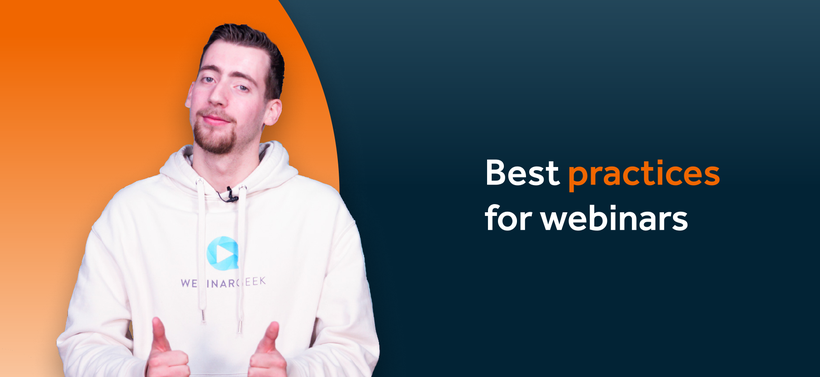9 Best practices for beginners to host a webinar
Pam
19 January 2023 - 5 min
Web conferences, also known as webinars, have become an increasingly popular way for businesses and organizations to connect with their audience, clients, and employees. Whether you’re hosting a webinar for the first time or you’re an experienced pro, it’s always a good idea to brush up on the best practices for hosting a successful webinar.
Here are some best practices for beginners to consider when hosting a webinar:
1) Choose the right platform
Number one is to choose the right platform. There are a number of platforms available for hosting webinars, but of course, we recommend using WebinarGeek! Each platform has its own features and pricing, and if you’re looking for an all-in-one solution, you’ve come to the right place. Consider the size of your audience, the type of content you’ll be presenting, and any specific features you might need. We are happy to help you get the most out of your webinars.
2) Promote your webinar
Make sure to promote your webinar to your target audience in advance. This can be done through email marketing, social media, and other channels. Be sure to include the date, time, a brief description of the topic, and your registration link in your promotion. You may also consider offering an incentive, such as a discount or free gift, to encourage people to attend. Need more inspiration on best practices? We’ve got you covered. There’s a ton of information on the blog about Webinar marketing.
3) Test your technology
It’s essential to test your webinar setup well in advance to ensure that everything works as it should. Test your microphone, webcam, and any other equipment you’ll be using during the webinar. Always have a backup plan in case of technical issues. Not sure where to start? WebinarGeek has the best support team in the industry. Send us a message on the chat and our technical engineers will help you in minutes.
4) Engage your audience
One of the benefits of hosting a webinar is the ability to interact with your audience in real time. Encourage participation by asking for feedback, and using the interactions like polls and quizzes. You can also use tools like chat to create a more interactive experience. Another best practice is to ask questions to your audience! It can be really simple, ask where they are from for example, or how they are feeling today. End your webinar with a Q&A to cover all your audience's questions and create a true live experience.
5) Use visual aids
Visual aids, such as slides, videos, and screen sharing, can help to keep your audience engaged and make your content more memorable. A few things to keep in mind: use high-quality images and keep the number of slides low so as not to overwhelm your audience. You can also alternate between presenting live and using videos. When you add videos to your webinar, you keep your audience engaged and have time to take a breath and prepare for the next part of your webinar. A win-win situation for everyone!
6) Keep it concise
It’s important to keep your webinar as concise as possible, especially if you have a large audience. The best is to aim for a length of 45-60 minutes, including any Q&A time. Practice before you go live to time your webinar. You want your audience to stay focussed on your webinar and not leave the webinar room before you’ve shared your special offer at the end of the webinar, redirected the viewers to your website, or answered all the questions in the Q&A!
7) Choose the right time to host the webinar
A lot of effort goes into preparing your webinar! Of course, you want to plan your webinar at the best time for your target audience so that everyone can join. Who is your target audience? B2B or B2C? And are they free at the time you want to plan the webinar? Is it a holiday? These are things to consider when choosing the right time. We wrote an elaborate blog about the best time to host a webinar.
8) Plan reminder emails
Make sure to remind the subscribers of your webinar! Everybody is busy these days, and chances are that people forget when the webinar is. You can send a reminder email a couple of days before the webinar, an hour before the webinar starts, and when you’re live. Sending reminder emails is one of the best ways to keep your webinar on top of mind.
9) Follow-up!
After the webinar, be sure to follow up with your attendees. You can send a thank you email, offer any additional resources or materials, and invite them to join your email list or social media channels. You can also use the opportunity to gather feedback and make any necessary improvements for future webinars! Did people miss the webinar? Send the replay to the non-viewers so that they can still watch it whenever they want.
By following these best practices, your webinar will be engaging, informative, and memorable for your audience. With a bit of preparation and planning, you can effectively connect with your audience and achieve your goals through webinars.
Start hosting webinars today!
Try for free nowRelated articles
Why Webinar Analytics Matter and How They Improve Your Results
Discover why webinar analytics are essential for better engagement, stronger follow-up, and smarter decisions. Learn which metrics matter and how to use them to improve every webinar.
How to Use Localization to Reach More People With Less Work
Discover how localization in WebinarGeek lets you host one webinar in multiple languages. Increase reach, improve accessibility, and create a consistent brand experience for international audiences.
Local experience for a global audience
Webinars work best when your audience feels right at home. With WebinarGeek’s localization feature, you can present your webinars, emails, and registration pages in the language your viewers understand.
/f/110864/617x610/445d6c9238/pam_2.png)

/f/110864/1813x833/de2d623e61/best-practices-for-webinars-1.png)

/f/110864/1200x630/03bf441907/why-webinar-analytics-matter-and-how-they-improve-your-results.jpg)

/f/110864/1201x631/f714691cde/how-to-use-localization-to-reach-more-people-with-less-work.jpg)

/f/110864/1920x1005/41bece797c/translation.png)
